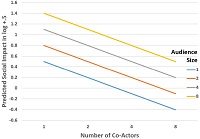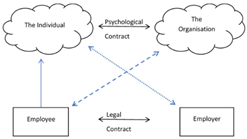Self-efficacy and means-efficacy as a strategy for reducing resistance to change—Transition from frontal learning to asynchronous learning
Abstract
Modern organizations often face challenges implementing initiatives due to the rapidly changing business landscape and encountering internal obstacles like resistance and delays. This research examines the application of the internal and external efficacy model and its effect on resistance to change in work organizations by raising self-efficacy and means-efficacy (a person’s belief in the ability of the tools available to him to perform the task). Raising the two types of efficacies creates a Pygmalion effect in which high expectations for successful performance encourage the investment of efforts; therefore, ultimately, they will lead to more successful performances. In addition, since individuals with an external locus of control place a higher emphasis on resources that are external to them, the moderating effect of the degree of locus of control on the relationship between means-efficacy and resistance to change was studied. The study that included 138 participants was conducted in a logistics and international forwarding company in Israel and examined a change in learning method from face-to-face learning to an asynchronous learning module. During the study, the level of self-efficacy and means-efficacy of participants was raised, and the level of resistance to change and the level of locus of control as a personality trait were measured. The study showed a distinct effect of increasing self-efficacy on the degree of resistance to change (t = −1.66, p < 0.05), but no significant effect of increasing means efficacy on resistance to change was found (t = −0.87, p > 0.05). The effect of means-efficacy on the degree of resistance was found to be moderated by locus of control (t = −2.3, p < 0.05), meaning that those who had an external locus of control were more impacted by the increase in means-efficacy. This means that people with an external locus of control are more affected by means-efficacy than by self-efficacy.
References
Agars, M. D. (2010). Perceptions of resources matter: Means efficacy and career hoices. In: Proceedings of the 25th Annual Conference of the Society for Industrial and Organizational Psycholog; 6–10 August 2010; Atlanta, GA, USA.
Agars, M., and Kottke, J. L. (2021). Development of a theoretical framework and a measure of general organizational means-efficacy. Human Performance, 34(1), 1–24. https://doi.org/10.1080/08959285.2020.1821378
Akmalia, R., Nst, W. N., and Siahaan, A. (2023). Influence of Self-Efficacy, Organizational Culture, and Job Satisfaction on The Performance of Madrasah Aliyah Teachers. Nidhomul Haq Jurnal Manajemen Pendidikan Islam, 8(3), 437–453.
Alisic, A., Wiese, B. S. (2020). Keeping an insecure career under control: The longitudinal interplay of career insecurity, self-management, and self-efficacy. Journal of Vocational Behavior, 120, 43-51. https://doi.org/10.1016/j.jvb.2020.103431
Amiot, C. E., Terry, D. J., Jimmieson, N. L., Callan, V. J. (2006). A longitudinal investigation of coping processes during a merger: Implications for job satisfaction and organizational identification. Journal of Management, 32, 552–574. https://doi.org/10.1177/0149206306287542
Armenakis, A. A., Harris, S. G., Mossholder, K. W. (1993). Creating readiness for organizational change. Human relations, 46(6), 681–703. https://doi.org/10.1177/001872679304600601
Ashagi, M. M., Beheshtifar, M. (2015). The relationship between locus of control (internal-external) and self-efficacy beliefs of Yazd University of Medical Sciences. International Journal of Engineering and Applied Sciences, 2(8), 2–6.
Bandura, A. (1997). Self-efficacy: The exercise of control. Freeman Publishing.
Burnes, B. (2015). Understanding resistance to change–building on Coch and French. Journal of change management, 15(2), 92–116. https://doi.org/10.1080/14697017.2014.969755
Caliendo, M., Kritikos, A. S., Rodriguez, D., Stier, C. (2023). Self-efficacy and entrepreneurial performance of start-ups. Small Business Economics, 61(3), 1027–1051. https://doi.org/10.1007/s11187-022-00728-0
Chen, S., Westman, M., Eden, D. (2009). Impact of enhanced resources on anticipatory stress and adjustment to new information technology: A field-experimental test of Conservation of Resources Theory. Journal of Occupational Health Psychology, 14, 219–348. https://doi.org/10.1037/a0015282
Coleman-Oliver, S. L. (2018). A multi-dimensional analysis of leadership competencies and resistance to change [PhD thesis]. North Carolina Agricultural and Technical State University.
Conner, D. (2012). The dirty little secret behind the 70% failure rate of change projects. Available online: http://www.connerpartners.com (accessed on 2 December 2024).
Cunningham, C. E., Woodward, C. A., Shannon, H. S., et al. (2002). Readiness for organizational change: A longitudinal study of workplace, psychological and behavioral correlates. Journal of Occupational and Organizational Psychology, 75, 377–392. https://doi.org/10.1348/096317902321119637
Eden, D. (2001). Means efficacy: External sources of general and specific subjective efficacy. In: Erez, M., Kleinbeck, U., Thierry, H. (editors). Work motivation in the context of a globalizing economy. Lawrence Erlbaum. pp. 73–86.
Eden, D., Ganzach, Y., Flumin-Granat, R., Zigman, T. (2010). Augmenting means efficacy to boost performance: Two field experiments. Journal of Management, 36(3), 687–713. https://doi.org/10.1177/0149206308321553
Fløvik, L., Knardahl, S., Christensen, J. O. (2019). Organizational change and employee mental health. Scandinavian journal of work, environment & health, 45(2), 134–145. https://doi.org/10.5271/sjweh.3777
George, G., Camarata, M. R. (1996). Managing instructor cyberanxiety: The role of self-efficacy in decreasing resistance to change. Educational Technology, 36(4), 49–54.
Herold, D. M., Fedor, D. B., Caldwell, S. D. (2007). Beyond change management: A multilevel investigation of contextual and personal influences on employees’ commitment to change. Journal of Applied Psychology, 92, 942–951. https://doi.org/10.1037/0021-9010.92.4.942
Holmes, B. H., Werbel, J. D. (1992). Finding work following job loss: The role of coping resources. Journal of Employment Counseling, 29, 22–29. https://doi.org/10.1002/j.2161-1920.1992.tb00148.x
Jones, S. L., Van de Ven, A. H. (2016). The changing nature of change resistance: An examination of the moderating impact of time. The Journal of Applied Behavioral Science, 52(4), 482–506. https://doi.org/10.1177/0021886316671409
Kumar, P., Saxena, C., Baber, H. (2021). Learner-content interaction in e-learning-the moderating role of perceived harm of COVID-19 in assessing the satisfaction of learners. Smart Learning Environments, 8, 1–15. https://doi.org/10.1186/s40561-021-00149-8
Levenson, H. (1981). Differentiating among internality, powerful others, and chance. In: Lefcourt, H. M. (editor). Research with the Locus of Control Construct. Academic Press. pp. 15–63.
Lokman, A., Hassan, F., Ustadi, Y. A., et al. (2022). Investigating motivation for learning via Vroom’s Theory. International Journal of Academic Research in Business and Social Sciences, 12(1), 504–530. https://doi.org/10.6007/IJARBSS/v12-i1/11749
Martin, A. J., Jones, E. S., Callan, V. J. (2005). The role of psychological climate in facilitating employee adjustment during organizational change. European Journal of Work and Organizational Psychology, 14, 263–283. https://doi.org/10.1080/13594320500141228
Omieno, K. (2022). A Critical Review of Technology Adoption Theories and Models for E-Learning Systems, Kenya. International Journal of Innovation Engineering and Science Research, 6(2), 7-15.
Oreg, S. (2006). Personality, Context, and resistance to organizational change. European Journal of Work and Organizational Psychology, 15, 73–101. https://doi.org/10.1080/13594320500451247
Padilla, P., Agars. M. D. (2014). When self and Means-Efficacy affect performance: The tole of locus of control. In: Proceedings of the 122nd Annual Convention of the American Psychological Association; 7–10 August 2014; Washington, DC, USA.
Paglis, L. L., Green, S. G. (2002). Leadership self‐efficacy and managers’ motivation for leading change. Journal of Organizational Behavior: The International Journal of Industrial, Occupational and Organizational Psychology and Behavior, 23(2), 215–235. https://doi.org/10.1002/job.137
Peppard, J. (2020). Rethinking the concept of the IS organization. In: Strategic Information Management. Routledge. pp. 309–334.
Rotter, J. B. (1966). Generalized expectancies for internal versus external control of reinforcement. Psychological Monographs, 80(1), 609.
Schmierer, N., Jones, M. M., Agars, M. D., Kottke, J. L. (2009). Examining means-efficacy and turnover intentions in workers with disabilities. In: Proceedings of the 24th Annual Conference of the Society for Industrial and Organizational Psychology, 2–4 April 2009; New Orleans, LA, USA.
Schunk, D. H., DiBenedetto, M. K. (2021). Self-efficacy and human motivation. Advances in motivation science, 8; 153–179. https://doi.org/10.1016/bs.adms.2020.10.001
Simmons, A. L., Payne, S. C., Pariyothorn, M. M. (2014). The role of meansefficacy when predicting creative performance. Creativity Research Journal, 26(1), 53–61. https://doi.org/10.1080/10400419.2014.873667
Srivastava, S., Agrawal, S. (2020). Resistance to change and turnover intention: A moderated mediation model of burnout and perceived organizational support. Journal of Organizational Change Management, 33(7), 1431–1447. https://doi.org/10.1108/JOCM-02-2020-0063
Stirin K., Ganzach Y., Pazy A., Eden D. (2012). The effect of perceived advantage and disadvantage on performance: The role of external efficacy. Applied psychology: An International Review. 61 (1), 81–96. https://doi.org/10.1108/JOCM-02-2020-0063
Vroom, V. H. (1964). Work and motivation. John Wiley Publishing.
Wanberg, C. R., and Banas, J. T. (2000). Predictors and outcomes of openness to changes in a reorganizing workplace. Journal of Applied Psychology, 85, 132–142. https://doi.org/10.I037//0021-9010.85.1.132
Copyright (c) 2025 Author(s)

This work is licensed under a Creative Commons Attribution 4.0 International License.









